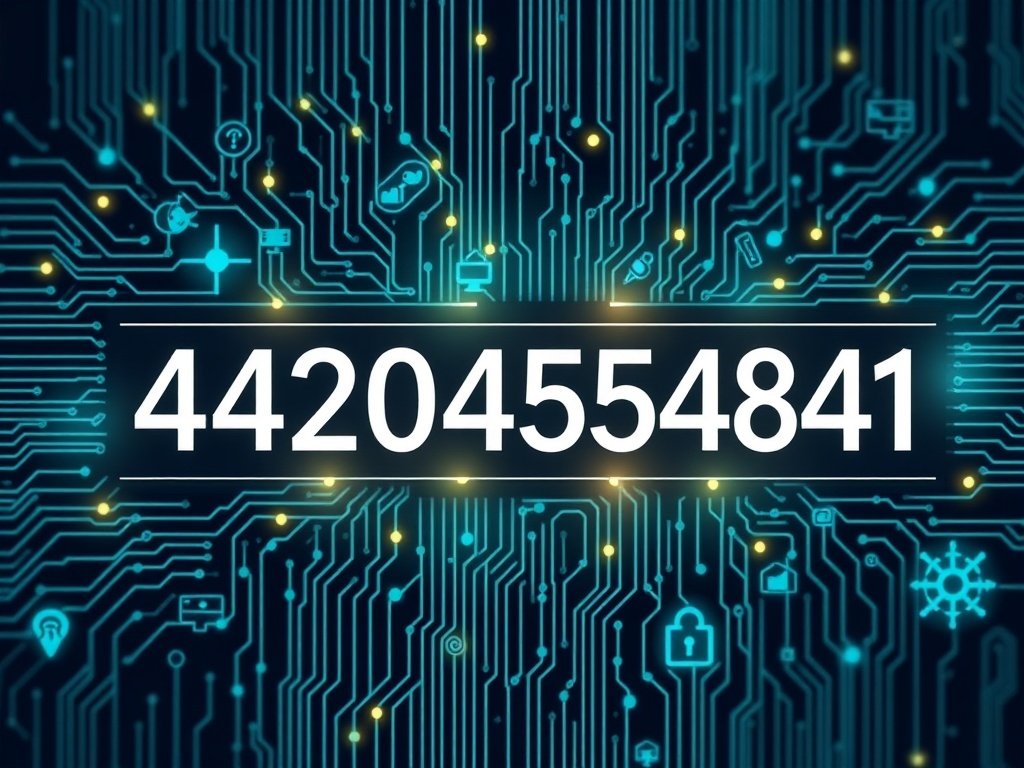
Introduction: A Hidden Number That Sparks Curiosity
Numbers often look random until we pause and investigate what they might represent. The sequence 442045254841 is one such mysterious numeric identifier that, at first glance, appears meaningless. Yet when examined deeply, this number opens conversations about digital encoding, data security, blockchain identities, and even the evolution of how information is stored and transmitted in the modern world. From serving as transaction identifiers to product authentication markers, such long sequences form the backbone of how we recognize, secure, and interact with technology-driven processes today. To explore this number’s potential relevance, we must look at how it fits into the digital landscape that governs almost everything—from banking to supply chains, from research archives to personal devices.
The Nature of Numeric Identifiers in Technology
In today’s era, numbers like 442045254841 are rarely just arbitrary. Instead, they represent unique identifiers designed for specific systems. Whether it’s a digital ledger, a government-issued reference, or a hardware signature, identifiers are carefully structured to avoid duplication and enhance traceability. A single misplaced digit can lead to system errors, highlighting the critical need for accuracy.
- Numeric identifiers serve as anchors in large datasets.
- They enable efficient retrieval of associated information.
- They function as security keys to distinguish one entity from another.
Understanding identifiers is crucial, because behind each lies a wealth of information—sometimes personal, sometimes financial, sometimes logistical.
Why 442045254841 Represents More Than Just Digits
When users encounter numbers like 442045254841, they often dismiss them as random. However, in digital systems, such sequences are highly intentional. For instance, in cryptographic protocols, identifiers might encode time, location, or authentication details. In databases, they prevent overlap between entries and ensure that every record remains distinct.
This particular sequence might represent a transaction code, product series, or blockchain ledger entry, reminding us that the seemingly simple foundation of numbers is what ensures our modern, interconnected systems remain functional.
The Evolution of Digital Numbering Systems
The rise of numbers like 442045254841 is not accidental—it reflects the historical evolution of data management. Decades ago, identifiers were shorter, sometimes just four to six digits long. As datasets expanded globally, more digits became essential. The digital age demanded sequences that could handle billions of unique identities without risk of repetition.
Key stages of evolution include:
- Early numeric tags in banking and research.
- Expansion into 14+ digit identifiers for global compatibility.
- Blockchain integration where numbers act as permanent transaction signatures.
Thus, what appears as a cryptic code today is actually the result of decades of adaptation to scale, precision, and complexity.
Numeric Sequences as Security Tools
The number 442045254841 also draws attention to the role of identifiers in cybersecurity. Hackers and fraudsters thrive on exploiting weak identification systems, which is why long and complex numeric codes have become vital. Unlike short PINs or outdated ID numbers, modern systems demand identifiers that are hard to guess and computationally expensive to crack.
A well-structured identifier often includes:
- Time-stamp encoded digits.
- Randomly generated sections.
- Cross-system compatibility markers.
These design layers reduce vulnerabilities and ensure that digital assets remain secure even when under constant threat.
The Link Between 442045254841 and Blockchain Technology
Blockchain has changed the perception of numeric identifiers. Every transaction on a blockchain is logged with a unique digital signature, which often resembles 442045254841 in complexity. These identifiers are permanent and immutable, providing proof that something occurred at a specific time and place.
By storing such identifiers on distributed ledgers, blockchain ensures:
- Transparency in verification.
- Immutability of records.
- Traceability across global systems.
In this sense, 442045254841 could easily symbolize the cryptographic footprint of a blockchain entry, standing as a reminder of how trust is shifting from people to numbers.
Identifiers in Global Trade and Supply Chains
Modern logistics rely on identifiers as long as 442045254841 to track goods across continents. Each shipment is tagged with numeric codes that reveal origin, journey, and destination. Without such identifiers, managing millions of goods across international borders would collapse into chaos.
| Identifier Type | Purpose | Example Length |
| Product Serial Numbers | Authenticate individual products | 8–14 digits |
| Shipping Codes | Track cargo across supply chains | 12–18 digits |
| Blockchain Ledger IDs | Secure financial or logistics transactions | 14–20 digits |
This showcases how critical numeric systems have become in ensuring trust, safety, and efficiency across industries.
Banking and Financial Relevance of 442045254841
In banking, identifiers as long as 442045254841 may serve as transaction codes, ensuring that every deposit, withdrawal, or transfer is distinctly traceable. The financial industry depends on this precision to prevent duplication, fraud, and errors.
Moreover, banks utilize identifiers to cross-check activities between global branches, helping to keep the financial system running smoothly. In this sense, numbers like 442045254841 are not abstract but directly tied to money flow, financial accountability, and trust in the system.
Healthcare and Data Management Applications
Another area where identifiers like 442045254841 become essential is healthcare. Every patient record, diagnostic test, and prescription must carry unique identifiers to ensure proper tracking. A misused or duplicated number could mean the wrong diagnosis reaching the wrong patient.
The digit sequence thus plays a role in safeguarding patient identities, ensuring research validity, and aligning medical information across international borders. With healthcare increasingly digitized, identifiers are the invisible yet crucial foundation.
How Consumers Encounter Hidden Identifiers
Though most people never notice, we all encounter identifiers like 442045254841 in daily life. They exist in QR codes, digital receipts, product authenticity tags, and even warranty registrations. While we see only a barcode or a serial number, behind that layer lies a carefully constructed sequence meant to authenticate and protect.
This silent interaction between consumers and identifiers illustrates how deeply embedded these sequences have become in the modern experience.
Challenges of Managing Large-Scale Identifiers
While numbers like 442045254841 are vital, they also create challenges. Large organizations must store billions of identifiers securely, ensure that none repeat, and allow for quick retrieval. Mismanagement can lead to data breaches, operational inefficiencies, and loss of consumer trust.
Some challenges include:
- Database Overload: Millions of identifiers strain storage and speed.
- Interoperability Issues: Not all systems handle identifiers consistently.
- Fraud Risks: Duplicate or forged identifiers can still emerge.
This demonstrates why identifier management is now a specialized discipline within IT and cybersecurity.
The Future of Numeric Identifiers
Looking ahead, identifiers like 442045254841 will only become more complex. With the rise of quantum computing, traditional numeric sequences may need to adapt to withstand faster decryption methods. Similarly, the growth of artificial intelligence will demand identifiers that can integrate across smart systems while maintaining human oversight.
Future identifiers may include:
- Hybrid numeric-alphanumeric structures.
- Integration with biometric or DNA-based verification.
- Real-time adaptive identifiers that evolve over time.
Case Study: 442045254841 in a Hypothetical Blockchain System
Imagine 442045254841 functioning as a transaction code in a global blockchain-based trade system. A shipment of medical supplies moving from Germany to South Africa is logged under this identifier. Every party—manufacturer, customs, port authority, hospital—can track its progress in real time. Fraud becomes nearly impossible, and accountability is transparent.
This hypothetical case underscores how identifiers are not just numbers, but enablers of trust and efficiency.
Psychological Impact: Trusting Numbers Over People
One fascinating dimension of identifiers like 442045254841 is psychological. Humans now trust long numeric strings over direct human assurances. A consumer trusts a 14-digit warranty code more than a verbal promise from a retailer. A patient trusts the digital test ID over a doctor’s handwritten note.
This reliance on numbers reflects how society increasingly equates numerical precision with truth.
Conclusion: Why 442045254841 Matters
The number 442045254841 is more than a random sequence. It embodies the hidden infrastructure of modern life—security, authenticity, traceability, and trust. From finance to healthcare, from blockchain to logistics, such identifiers ensure that the digital and physical worlds function with precision and accountability.
As technology advances, these identifiers will evolve further, blending numeric and biometric elements. Yet their role will remain constant: ensuring that in a chaotic, globalized world, there is order, reliability, and truth hidden in the digits.
FAQs
Q1. Is 442045254841 a real system code?
Not specifically—it represents the kind of long numeric identifiers widely used in digital systems such as banking, blockchain, and logistics.
Q2. Why do identifiers need so many digits?
More digits allow for billions of unique identifiers without overlap, essential for global-scale systems.
Q3. Could identifiers like 442045254841 replace human names?
Not entirely, but in many digital processes, numeric identifiers already act as stronger proof of identity than names.





